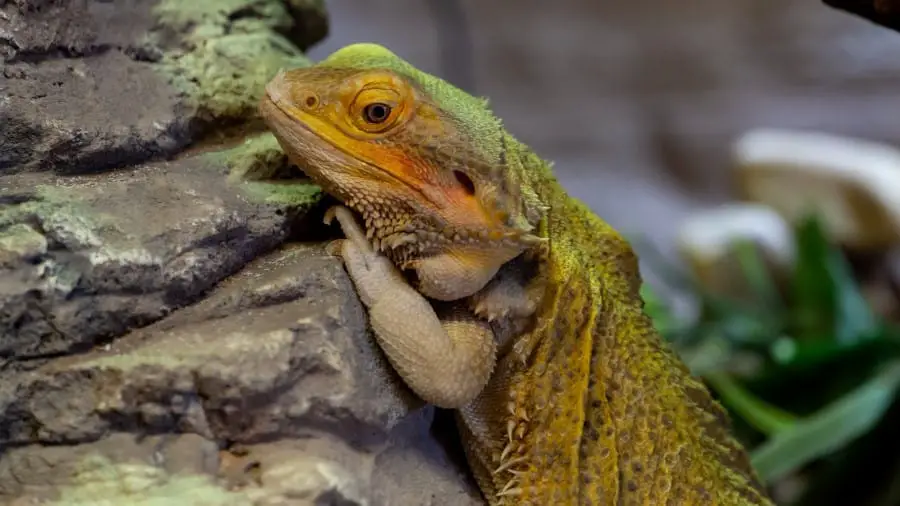
Some creatures are social while others are solitary depending on their situation, but where do bearded dragons lie? Most reptiles are known to be very solitary animals but experts claim that some are more sociable than others. Are bearded dragons sociable animals or do they prefer to live their life in solitary?
Bearded dragons are largely solitary animals in the wild. With that said, they are sociable to an extent when domesticated. Bearded dragons are considered to be the most sociable among reptiles because they can handle human interaction and their attention very well.
Unlike most other reptiles, bearded dragons are very sociable animals even though they are territorial in the wild. It’s very easy to interact and teach a bearded dragon things that you would teach a dog. Do bearded dragons socialize well with other creatures or does it only apply to human caretakers?
Do Bearded Dragons Socialize Well With Humans?
Yes, they socialize very well with humans. Typically, reptiles should not be handled because they hate it. However, when it comes to bearded dragons, they can take handling very well. They can even form bonds with their human caretakers to a point where they become protective of their owners.
Some bearded dragons are extremely friendly before they are even brought home by warming up to strangers that are eager to bring a new companion home. Here are some of the other things that bearded dragons can do with their human caretakers though.
Learning Their Names
Language isn’t a thing that can be shared between you and your bearded dragon. With that said, they can learn their name and respond to it. Bearded dragons don’t really know that it’s their name but they will know how to associate the word with themselves with time.
This is done by calling out their names in a similar tone every time so that they know you are calling them specifically and not just a random word. Whenever you engage in any kind of activity with your bearded dragon, try to call out its name as much as possible when handling it.
This can be whenever you feed them, clean their tanks, or bring them out for a walk. You will need to really concentrate on trying to form the same sound every time or else they will just assume you are calling something else.
Quality Time
Unlike other reptiles, it’s possible to spend a lot of quality time with your bearded dragon doing things that you usually do with other pets. They can be allowed to roam around the house daily for a set time which contributes to their daily exercise regiment.
Not only that, but they enjoy casual walks outdoors as well. For safety’s sake, you should keep an eye on them at all times as they can injure themselves fairly easily outdoors.
Not only that, but bearded dragons are very annoyed by all the outdoor noise which can be read in this article. It’s also recommended that you should bring them to your garden or backyard as much as you can during playtime.
Bearded dragons enjoy strolling along with the flowers and even climb some trees and fences if that is available to them. Moreover, you can also use toys to play with them.
They love to play ball and are very happy if you play catch with them. Cat toys are also a very good option for bearded dragons to pass the time. Floaties are also great for them to lay comfortably on top during leisure time.
Do Bearded Dragons Socialize Well With Other Animals?
In the wild, bearded dragons are very territorial creatures. They don’t like the company of others because they are fighting for survival.
Another animal in their area simply means that they need to share the resources around them so they would rather just be alone. Bearded dragons that see each other will likely fight for dominance in the area.
They are more likely to get along with animals of another species rather than their own. However, this is more prominent among male bearded dragons than females.
In a domestic setting, on the other hand, bearded dragons are very good at socializing with other animals. It takes some time but the possibility of your bearded dragon bonding with your dog is significantly higher than any other reptile pet in a household.
As soon as they learn of each other’s scent, they will start to familiarize themselves with each other. You should never leave them alone unsupervised though because anything can happen when an animal feels threatened by the other.
Their instincts will take over as soon as they feel scared. There are certain signs you can see on a bearded dragon to tell if they are socializing well though…
How Can You Tell If Bearded Dragons Are Socializing Well?
Bearded dragons may not be able to verbally tell you how they are feeling, but they do have certain actions that can though. Here are some of the ways your bearded dragon can tell you if they are socializing well or badly.
Arm Waving
If you’ve noticed, bearded dragons usually do a weird waving movement with their hands that perfectly imitates a human’s wave. You may think that it’s just them saying hi but it actually means a lot more under the surface.
This is actually a sign of submission or aggression depending on how they do it. Slow waves are usually a sign of friendly submission because it shows that they mean no harm.
Fast waves are signs of aggression that they might be feeling a little threatened or annoyed. It’s not unusual to see this with a new bearded dragon as you walk up on it. You will also see this behavior whenever other animals walk into their territory.
Beard Flaring
This is one of their most well-known gestures that is known throughout the world. It’s also the reasons why they are named “bearded dragons” with the “beards” on their chins.
This is the same as any other animal that puffs up as a sign of aggression towards others. They will only do this when they are intimidated as a way to intimidate their opponents back.
In the wild, it’s common to think that larger animals are more threatening, therefore, it’s a common response to puff up in size to try and one-up the other.
You will typically see this in conjunction with the next sign which brings me to my next point…
Color Changing
Like chameleons, bearded dragons can change color as well, albeit in a more limited way. Bearded dragons can only change certain parts of their bodies like their beards and chest, not to mention their colors are more limited as well.
They will turn black when they feel threatened. This can indicate a lot of things, but it’s closely associated with stress, illness, or intense emotion.
It’s best to leave your bearded dragon alone whenever this happens so that you don’t further irritate it. This response is usually accompanied by other behaviors on this list. The most common one of all though…
Head Bopping
Sometimes, you see your bearded dragon bopping its head as if it was vibing with the beat. This is a response to the things around them as a way to assert their presence and dominance towards others.
It may seem as if it’s giving you an affirmative answer to your other animals, but they might start to act aggressively if their message isn’t clearly sent. This is especially true if two male bearded dragons clash with each other.
One bearded dragon will be more dominant than the other and will bop its head towards it telling it who’s the boss around the enclosure.
Don’t Mistake Survival for Solidarity
Some people tend to think that wild bearded dragons are solitary because they hate the company of others. That isn’t true for all bearded dragons because they have different personalities which makes some more sociable than others.
The difference here is, bearded dragons are always fighting for survival in the wild where resources are scarce and shared. It’s very normal for a bearded dragon to want to hoard every single resource available to them in case they needed it for a rainy day.
This is why two bearded dragons in the same enclosure might get along but still fight when it comes to food. They can socialize with each other but since food is vital for survival, they will try to keep it for themselves.
Not to mention the fact that bearded dragons have a very strong sense of competition among themselves. Male bearded dragons are very territorial and may not feed comfortably within another’s presence.
Ideally, you shouldn’t try to socialize multiple bearded dragons in one enclosure or you might risk them fighting over dominance which causes unhealthy stress to them.
On the other hand, if multiple mixed-sex bearded dragons gather, they might cause excessive breeding.
Conclusion
Bearded dragons may be solitary for survival’s sake, but they are very sociable creatures that can get along with others. They can socialize with humans very well and form bonds with them that other reptiles can’t.
Moreover, bearded dragons can also form social bonds with other animals in their household but it does take some time before they get to know each other. Don’t try to force it upon them or else they might become extremely stressed from the experience.
There are several signs to look out for when trying to see if a bearded dragon can socialize with others. If you see that your bearded dragon is starting to show signs of stress or aggression, it’s best to leave it alone and try it again some other day when they have calmed down.
Bearded dragons aren’t really solitary animals but some are more sociable than others. Now go out there and try to make friends with your bearded dragon so that everyone can live in perfect harmony.


